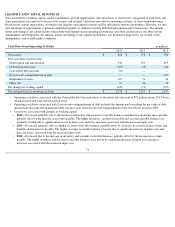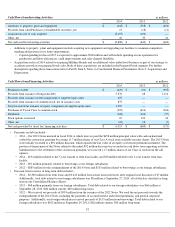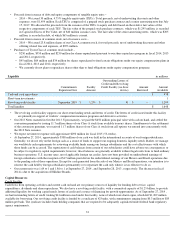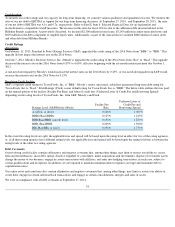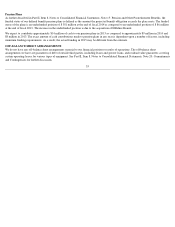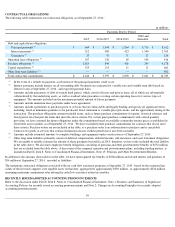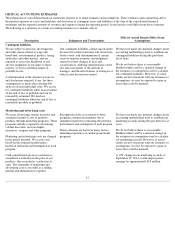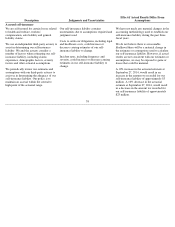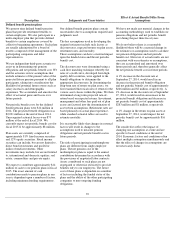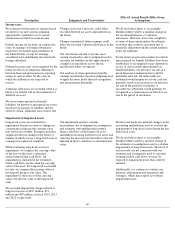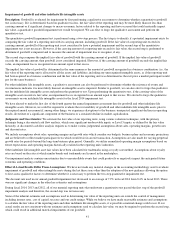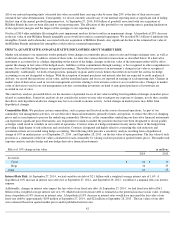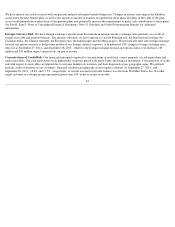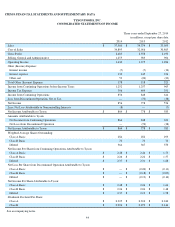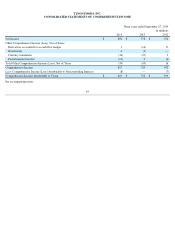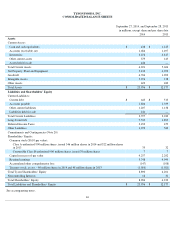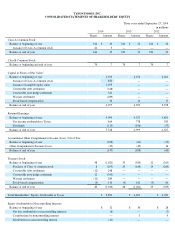Tyson Foods 2014 Annual Report Download - page 45
Download and view the complete annual report
Please find page 45 of the 2014 Tyson Foods annual report below. You can navigate through the pages in the report by either clicking on the pages listed below, or by using the keyword search tool below to find specific information within the annual report.
40
Description
Judgments and Uncertainties
Effect if Actual Results Differ From
Assumptions
Income taxes
We estimate total income tax expense based
on statutory tax rates and tax planning
opportunities available to us in various
jurisdictions in which we earn income.
Federal income tax includes an estimate for
taxes on earnings of foreign subsidiaries
expected to be taxable upon remittance to
the United States, except for earnings
considered to be indefinitely invested in the
foreign subsidiary.
Deferred income taxes are recognized for the
future tax effects of temporary differences
between financial and income tax reporting
using tax rates in effect for the years in
which the differences are expected to
reverse.
Valuation allowances are recorded when it is
likely a tax benefit will not be realized for a
deferred tax asset.
We record unrecognized tax benefit
liabilities for known or anticipated tax issues
based on our analysis of whether, and the
extent to which, additional taxes will be due.
Changes in tax laws and rates could affect
recorded deferred tax assets and liabilities in
the future.
Changes in projected future earnings could
affect the recorded valuation allowances in the
future.
Our calculations related to income taxes
contain uncertainties due to judgment used to
calculate tax liabilities in the application of
complex tax regulations across the tax
jurisdictions where we operate.
Our analysis of unrecognized tax benefits
contains uncertainties based on judgment used
to apply the more likely than not recognition
and measurement thresholds.
We do not believe there is a reasonable
likelihood there will be a material change in
the tax related balances or valuation
allowances. However, due to the complexity
of some of these uncertainties, the ultimate
resolution may result in a payment that is
materially different from the current estimate
of the tax liabilities.
To the extent we prevail in matters for which
unrecognized tax benefit liabilities have been
established, or are required to pay amounts in
excess of our recorded unrecognized tax
benefit liabilities, our effective tax rate in a
given financial statement period could be
materially affected. An unfavorable tax
settlement would require use of our cash and
generally result in an increase in our effective
tax rate in the period of resolution. A
favorable tax settlement would generally be
recognized as a reduction in our effective tax
rate in the period of resolution.
Impairment of long-lived assets
Long-lived assets are evaluated for
impairment whenever events or changes in
circumstances indicate the carrying value
may not be recoverable. Examples include a
significant adverse change in the extent or
manner in which we use a long-
lived asset or
a change in its physical condition.
When evaluating long-lived assets for
impairment, we compare the carrying value
of the asset to the asset’s estimated
undiscounted future cash flows. An
impairment is indicated if the estimated
future cash flows are less than the carrying
value of the asset. For long-lived assets held
for sale, we compare the carrying value of
the disposal group to fair value. The
impairment is the excess of the carrying
value over the fair value of the long-lived
asset.
We recorded impairment charges related to
long-lived assets of $107 million, $74
million and $29 million, in fiscal 2014, 2013
and 2012, respectively.
Our impairment analysis contains
uncertainties due to judgment in assumptions
and estimates surrounding undiscounted
future cash flows of the long-lived asset,
including forecasting useful lives of assets and
selecting the discount rate that reflects the risk
inherent in future cash flows to determine fair
value.
We have not made any material changes in the
accounting methodology used to evaluate the
impairment of long-
lived assets during the last
three fiscal years.
We do not believe there is a reasonable
likelihood there will be a material change in
the estimates or assumptions used to calculate
impairments of long-lived assets. However, if
actual results are not consistent with our
estimates and assumptions used to calculate
estimated future cash flows, we may be
exposed to impairment losses that could be
material.
Additionally, we continue to evaluate our
domestic and international operations and
strategies, which may expose us to future
impairment losses.



